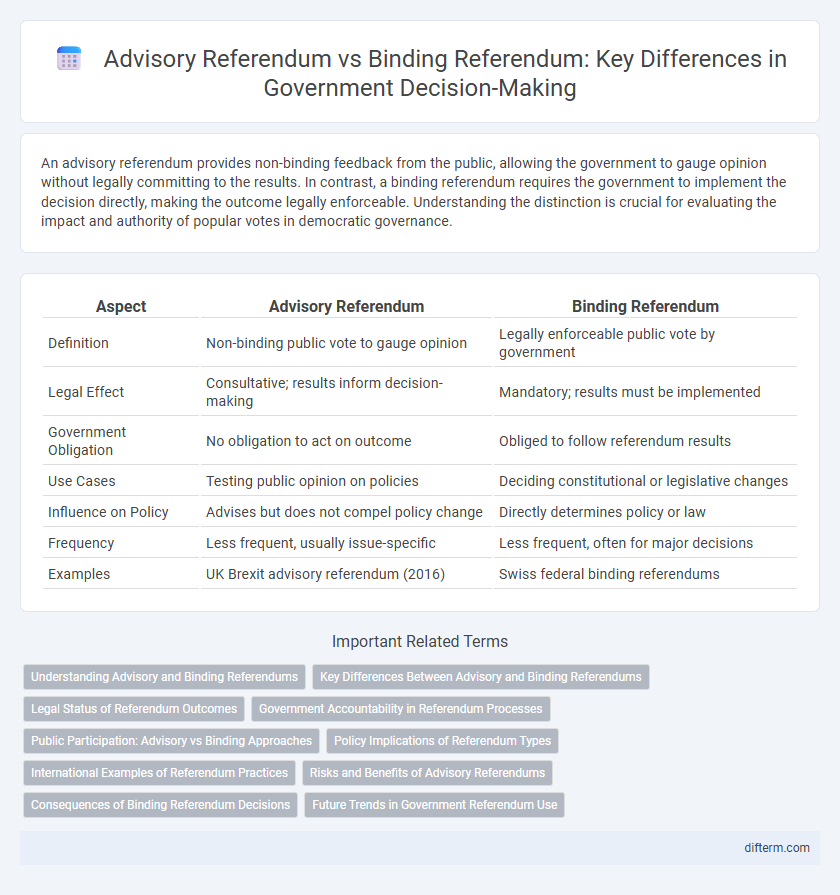An advisory referendum provides non-binding feedback from the public, allowing the government to gauge opinion without legally committing to the results. In contrast, a binding referendum requires the government to implement the decision directly, making the outcome legally enforceable. Understanding the distinction is crucial for evaluating the impact and authority of popular votes in democratic governance.
Table of Comparison
| Aspect | Advisory Referendum | Binding Referendum |
|---|---|---|
| Definition | Non-binding public vote to gauge opinion | Legally enforceable public vote by government |
| Legal Effect | Consultative; results inform decision-making | Mandatory; results must be implemented |
| Government Obligation | No obligation to act on outcome | Obliged to follow referendum results |
| Use Cases | Testing public opinion on policies | Deciding constitutional or legislative changes |
| Influence on Policy | Advises but does not compel policy change | Directly determines policy or law |
| Frequency | Less frequent, usually issue-specific | Less frequent, often for major decisions |
| Examples | UK Brexit advisory referendum (2016) | Swiss federal binding referendums |
Understanding Advisory and Binding Referendums
Advisory referendums provide non-binding public opinion to guide government decision-making without legal obligation to follow the outcome. Binding referendums require governments to implement the results, making the vote legally decisive on specific policies or constitutional changes. Understanding the distinction influences how governments engage citizens in direct democracy and shape policy legitimacy.
Key Differences Between Advisory and Binding Referendums
Advisory referendums serve as a tool for gauging public opinion without legally compelling government action, whereas binding referendums require authorities to implement the outcome as law. The primary difference lies in their legal enforceability, with binding referendums having a direct impact on legislation and policy decisions. Voter turnout and political consequences often vary, as binding referendums typically generate higher engagement due to their decisive nature.
Legal Status of Referendum Outcomes
Advisory referendums hold no legal obligation for governments to enact the result, serving primarily as a tool for gauging public opinion. Binding referendums impose legal requirements for the government to implement the decision, thus ensuring that the referendum outcome has direct legislative or policy consequences. The legal status of referendum outcomes significantly impacts the degree of political accountability and the enforcement of popular mandates within a democratic system.
Government Accountability in Referendum Processes
Advisory referendums provide non-binding public opinions that guide government decisions, serving as a tool for accountability by reflecting citizen preferences without mandating policy changes. Binding referendums legally oblige governments to implement the outcome, directly holding elected officials accountable for respecting voter decisions. Effective referendum processes enhance transparency and trust in democratic governance by ensuring that authorities respond appropriately to public mandates.
Public Participation: Advisory vs Binding Approaches
Advisory referendums serve as a tool for gauging public opinion without imposing legal obligations, allowing governments to consider citizen input in policy-making while retaining final decision authority. Binding referendums, by contrast, directly empower voters to determine policy outcomes, ensuring that public participation translates into legally enforceable decisions. The choice between advisory and binding approaches significantly impacts the degree of democratic engagement and the legitimacy of government actions.
Policy Implications of Referendum Types
Advisory referendums provide governments with public opinion guidance without legal obligation to implement results, allowing flexibility in policymaking and mitigating political risks. Binding referendums compel governments to enact policies as decided by voters, ensuring direct democratic legitimacy but potentially limiting legislative discretion and adaptability. The choice between referendum types significantly influences policy stability, public trust, and the balance between democratic participation and effective governance.
International Examples of Referendum Practices
Advisory referendums provide non-binding public opinion, exemplified by the UK's 2011 Alternative Vote referendum, which influenced but did not mandate parliamentary action. Binding referendums, such as Switzerland's frequent national votes on constitutional amendments, require government compliance with the electorate's decision. Countries like Italy balance both types, using advisory referendums to guide policy without obligatory enforcement, highlighting global diversity in referendum practices.
Risks and Benefits of Advisory Referendums
Advisory referendums allow governments to gauge public opinion on specific issues without imposing legal obligations, offering flexibility in policy-making but risking voter confusion and ambiguity regarding the weight of the result. These referendums can enhance democratic engagement by providing insight into citizen preferences while avoiding the rigid constraints of binding decisions that may not account for complex legal or fiscal considerations. However, the non-binding nature can lead to political exploitation or disregarded voter input, undermining trust in democratic processes.
Consequences of Binding Referendum Decisions
Binding referendum decisions mandate government actions, compelling legislative or executive bodies to implement the public's choice without discretion, thereby ensuring direct democratic influence on policy. Such outcomes can lead to irreversible legal and political changes, limiting the flexibility of lawmakers to adapt or amend the decisions post-referendum. The enforcement of binding results often impacts budget allocations, administrative procedures, and long-term strategic planning within government institutions.
Future Trends in Government Referendum Use
The future of government referendum use indicates a growing preference for advisory referendums to gauge public opinion without immediate legal obligation, allowing policymakers flexibility in decision-making. Advances in digital voting technologies are expected to increase the frequency and accessibility of both advisory and binding referendums, enhancing direct democratic participation. Governments may increasingly employ advisory referendums as a tool for consultation while reserving binding referendums for critical constitutional or major policy changes.
advisory referendum vs binding referendum Infographic

 difterm.com
difterm.com